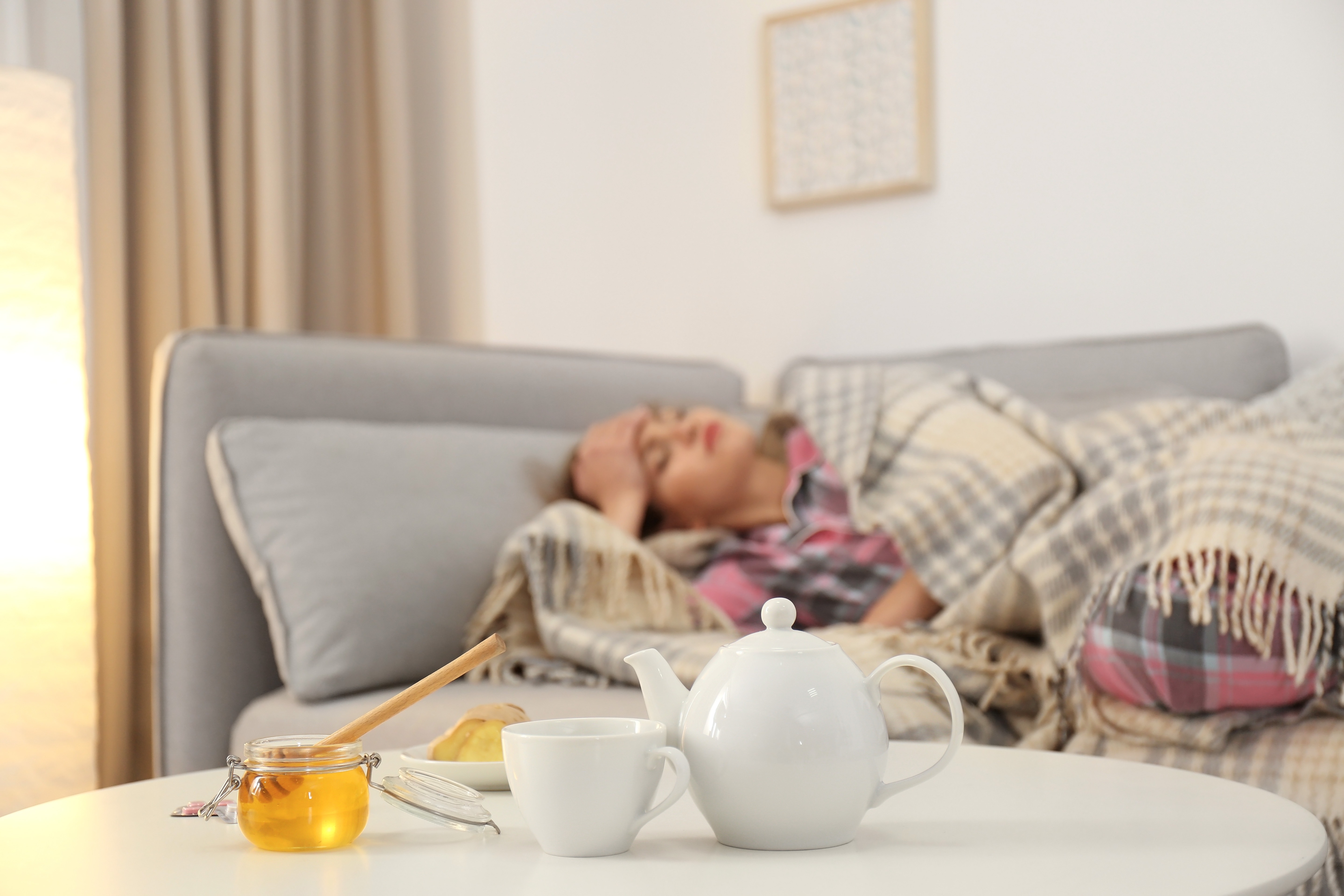Do Whole Home Dehumidifiers Really Work?
A whole home dehumidifier removes moisture from the air in your home. Unlike smaller, portable dehumidifiers that you manually move from room-to-room, a whole home dehumidifier is installed on the return duct of your HVAC unit to address the entire air volume of your home, not just one small area.
How does a whole house dehumidifier work?
Once installed on the return duct of your HVAC, the dehumidifier will remove moisture from all return air flowing back to your unit. As the air passes through the dehumidifier, a cooling coil will lower the air temperature. This causes water vapor in the air to condense into liquid form. The condensation will then drain out of the dehumidifier into a nearby drain. The remaining air exits the dehumidifier and enters your HVAC system for conditioning and then out into your home’s living areas via the HVAC blower fan.
 Will a dehumidifier remove all the moisture from the air?
Will a dehumidifier remove all the moisture from the air?
A dehumidistat on the unit will sense the air’s relative humidity level and remove moisture to decrease the airborne humidity to the desired levels indicated in your settings. We recommend the setting for this not be lower than 40% humidity. However, keep in mind that level may be hard to achieve in summer. Ideal humidity is 50%, but anything over 60% is going to be too high.
Do I need a whole home dehumidifier in Indiana?
Living in Indiana, the weather we have in the spring and early summer can be a bit unbalanced. It may only be 75 or 80 degrees outside, but the humidity can be at 80, 90, or 100%. So, while the air isn’t too hot, the humidity makes the air feel warmer than it is. This especially can be the case inside your home. Because it’s not as hot outside, your air conditioner may not be running as much as it would need to in order to remove all the humidity. So, the thermostat in your home may read 72 degrees, but if the humidity is high, it’s going to feel warmer than that. And many people think the answer to the high humidity is to turn the AC lower. But that’s not really going to help—a dehumidifier will.
A whole home dehumidifier is installed separate from your AC unit, so you don’t have to rely on the AC to run in order for the dehumidifier to do its job. Its sole purpose is to remove the sticky humidity from you home.
What are the benefits?
Better indoor air quality: High humidity levels can make your home feel muggy and uncomfortable. A dehumidifier can help create a more comfortable environment by reducing humidity levels and improving air quality. In addition to comfort disruption, high humidity levels can also lead to mold growth, dust mites, and other allergens. These can cause respiratory problems as well as potential damage to your home. Adding a whole home dehumidifier can make your more comfortable AND help you breathe easier!
Consistent climate control: Believe it or not, you may find you don't need to run the AC as much when you eliminate excess humidity from your house. This is all thanks to the cooling effects of the assist from the dehumidifier! By alleviating the stress of dehumidification, your air conditioner is able to cool your home more efficiently, which can result in lower cooling bills!
Dehumidifiers in the Indianapolis Area
If you’re tired of your home feeling muggy in the springtime or summer, contact us to learn more about whole home dehumidifiers and to get a quote for installation!
leaves in fall and the brisk air in winter. Come spring and summer, though, it’s another matter entirely. Poor indoor air quality during this time of year can feel either humid and stuffy, or terribly stale. A lot of people will crack open a window to try to fix the situation. But there’s a much better (and more efficient!) way to address your stale air problems.
Why Does the Air Feel Stale?
Stale air is created in a number of different ways. Some of the most common causes are from lack of ventilation and various contaminants. The odors and allergens from commercial cleaning products and dust mites are a big no-no for fresh indoor air. But without a good filtration system in place, it’s hard to keep these issues at bay. They just keep adding up to create that lingering stale air vibe.
Another reason your air can feel stale is because of improper humidity levels. Over time, poor circulation can make your indoor air feel even more stuffy. You need to introduce fresh air into your home and workspace to keep them from turning into “stale and stagnant” environments. Fortunately, adjusting your indoor humidity and making sure your ventilation system is efficient and clean can go a long way. A little maintenance or a couple upgrades are usually all it takes to get clean indoor air every day of the year!
4 Ways to Fix Stale Air
There’s no sense to live with uncomfortable indoor air. In fact, those conditions can be a real problem for productivity. Multiple studies have shown that poor ventilation reduces cognitive functions. To feel your best, it’s important to breathe good, clean air. You can help get your indoor air quality up to par with these solutions—listed in order of Okay, Good, Better, and Best:
1. Open a window—but not for too long.
If you’re struggling with stale air, you can always open a few windows. Just remember, this won’t be a real long-term solution. For one, this can add a bunch of sticky humidity to your indoor air. Opening the windows can also let a whole bunch of allergens fly inside. Pollen, dust, and other unwelcome odors (the neighbor’s lawnmower exhaust, for example) can slip into your space without the right filtration. Then you’re stuck with a bunch of other problems! Plus, leaving your windows open while the AC is running can be real energy waste. The money spent on cooling your space then, essentially, just floats outside.
2. Turn on the fan.
Another option is to put a new air filter into your HVAC unit and turn on your ceiling fan. Better yet—put your thermostat on its “Fan Auto” setting! Then you can recirculate the air without introducing new allergens to the mix. The counterclockwise direction on your fan can help push the cool air down to keep the space feeling fresh. This setup can be a great “quick fix” to kick off the new season.
3. Change your air filter.
A better way to improve your air is to put in a new filter. This can allow your AC to work more efficiently. Remember: 4 to 5-inch media filters should be swapped out every 6-12 months, but 1-inch air filters should be changed every one to two months. If you live in an area that has lots of construction going on or fields being plowed, you might need to change your filter more often. Putting in a new filter every month, or even every couple week might be necessary depending on your conditions. If you haven’t checked yours in a while, it’s probably due for a change.
4. Invest in a new filtration system or dehumidifier.
The best way to fix stale air problems is to clean up your indoor air around the clock. Homes and office spaces that are tightly-sealed sometimes need special systems installed. The right HVAC equipment will work to improve your indoor air by cycling it with filtered air from outside. But you might also want a new air cleaner or an add-on unit to tackle humidity issues. If you’re sick of stale air, these are great upgrades to help you breathe easy. Talk with your local HVAC company to find the best energy-efficient system for your layout!
Schedule an Indoor Air Quality Review
For the ultimate spring cleaning, don’t forget about your indoor air quality. The air we breathe affects us every minute of every day, so it deserves special attention. Ventilation problems with older homes and buildings can definitely take a toll. These environments can even cause different health issues, including headaches, eye irritation, and coughing. Typically, these problems are grouped together and referred to as sick building syndrome. The same issues from poor ventilation can also show up in your home.
When changing your air filters and turning on the ceiling fan aren’t enough to fix your stale air problems, it’s time to call on your local indoor air quality professionals. A quick review of your existing ventilation can help determine any problems spots that need improving. An upgraded air cleaner, dehumidifier, or ventilation system might be all you need for a truly refreshing, healthy lifestyle! Contact LCS Heating and Cooling today to learn more.
March 21, 2018
The wintertime weather can do a real number on our indoor comfort. Oftentimes, heating your home is only half of the solution. Dry air will continue to be a problem until spring rolls around. For the next couple months, indoor humidity is what really counts for home comfort.
Indiana homeowners tend to think that humidity is a bad thing. But don’t let our hot and extra-humid summers fool you. In reality, a little moisture can help make our air feel great—especially during the colder months.
Problems with Low Humidity Indoors
Dealing with low humidity, or dry air, comes with a slew of problems for you, your family, and even your home. Without a balanced level of moisture in your air, the winter can be a real drag.
1. You can get dry, scratchy skin.
It’s hard to feel your best when your lips are cracked and your hands are looking scaly. Forget the lotion. What your skin really needs is good air. When air has low humidity, it’s a lot easier for our skin to dry out. Moisturizer alone can’t fix the issue. Instead, you have to get the right amount of moisture back in your air.
2. It’s hard on your immune system.
Little known fact: Germs love dry air. It’s easier for microbes to float around when the humidity is low. As a result, more people tend to fall ill in the wintertime. Indoor humidity plays a big role in keeping your family healthy. Because viruses have a harder time moving in moist air, bumping up your indoor humidity can help give you an extra line of defense.
3. Dry air adds to sinus pain.
The moist membranes in your throat and nose work to filter out microbes, and proper humidity helps keep your body’s respiratory system in check. But when the air is dry, it can be hard on our sinuses. Itchy nasal passages get to be pretty painful, and might even cause nosebleeds if your environment isn’t balanced.
4. Your home’s wood might warp and crack.
Low humidity can impact the items in our homes, too. Wood furniture, instruments, and even our flooring can start to take a hit when dry air pulls out the moisture they’ve been holding. That’s why you might find your floorboards creaking more, or that you’re getting some unexpected damage to your belongings. It can also make doors get stuck in their frames.
5. Low humidity creates annoying static.
Although static might not have the same long-term effects like the other dry air problems, this issue is probably the most noticeable! Getting shocked by your pet, the couch, or doorknobs doesn’t have to be a hallmark of the winter season. Static only tends to build up in homes that have excessively dry air.
Reversing the Dry Air Symptoms
There are many different aspects of your health and lifestyle that are impacted by dry air. Fortunately, there’s one easy fix. Instead of trying to address each issue individually, why not tackle them all at once? That’s where a whole-house humidifier can help.
Because these units are installed with your existing ductwork and furnace, they can deliver the right amount of moisture all throughout your home. Whole-house humidifiers are great for homeowners that really want to maximize their comfort—and their health—all year long. Plus, they’re easy to maintain. Once installed, you can have a real fuss-free setup.
There’s no reason to put up with dry air problems this time of year. If you’re ready to have a home that you can really breathe easy in, give LCS Heating and Cooling a call at (317) 238-3961. We love helping homeowners find the right units for their home comfort. Contact us today to schedule an in-home consultation. Then we can make sure a whole-house humidifier makes sense for you and your lifestyle.
January 30, 2018
Dry air in the wintertime drags on and on, even long after the snow melts. It’s just how the season works. But there is an easy way to reverse the dry air issues. A lot of homeowners opt for a whole-house humidifier. It’s an affordable way to get quality indoor air for your family year-round!
What does a whole-house humidifier do?
Like the name suggests—these units take care of the air everywhere in your home. Instead of treating one small area, a whole-house humidifier gives you relief in every single room. It adds just the right amount of moisture back to your air. This can make a big difference in your day-to-day life.
A humidifier helps adjust your home’s dry air. By increasing your relative humidity, the unit:
- Keeps your skin soft in winter
- Improves your immune system
- Reduces allergy symptoms
- Protects your wood flooring, artwork, and instruments
- Minimizes annoying static shocks
Another benefit of having an appropriate humidity level is that it can improve your home’s energy efficiency. Dry air can make your home feel colder than it actually is. But when you add a little moisture back to your air, it helps you regulate your indoor temperature better. Most people feel more comfortable, so they can save on their energy costs instead of cranking up the heat.
What’s the best humidifier for my home?
Choosing the best whole-house humidifier for your family all depends on your home’s size and layout. Steam humidifiers and evaporative humidifiers have similar results, but get installed differently. A technician will need to come out to discuss your setup with you.
We primarily install Aprilaire whole-home humidifiers, but we’ve also worked with Lennox and Honeywell humidifier units. The latest systems are great because they self-regulate. You don’t really have to monitor or check the settings since they’re all automatic. The set-it-and-forget-it control options give you all the benefits of a healthy home humidity level with zero hassle. It’s the perfect fix for dry winter air.
How much does a whole-house humidifier cost?
A lot of people are surprised to learn about how affordable whole-house humidifiers are. It’s a relatively tiny upgrade because the unit works with your existing ductwork and HVAC system. But it still makes a big impact! (Kind of like getting whipped cream on your hot chocolate.)
In general, $700-$920 is the range for regularly-priced bypass and powered humidifiers. If you decide to go with a steam unit, the price is higher because there’s additional work that has to be done with the install.
The great thing about our humidifiers is that installation is already included in the package price. Our pricing is flat rate, so your humidifier package has everything you need to get set up. But even better—at LCS Heating & Cooling, we like to run seasonal specials. If you want to get a great deal on your whole-house system, just reach out to hear the latest savings options.
LCS Humidifier Service and Installation
The first few months of the year are often the best time to get your whole-house humidifier installed. A lot of homeowners want to use their tax rebates on practical home upgrades, and these units are definitely a smart option—especially with the seasonal savings.
Our current LCS Humidifier Special runs through March 31, 2017. Any customers in our greater Indianapolis service area get 15% off their installation. New and current Energy Savings Plan customers will get 25% off their whole-house humidifier installation. Pretty sweet, right?
Improving your family’s air quality is a surefire way to kick the winter blues and get ready for spring. Taking care of your dry air issues now means you’ll be all set for the end of the year and next winter. (And any dry skin and sore throat issues that come with it.) Any other questions on how these systems work? Get your consultation scheduled today to learn more!
February 10, 2017




